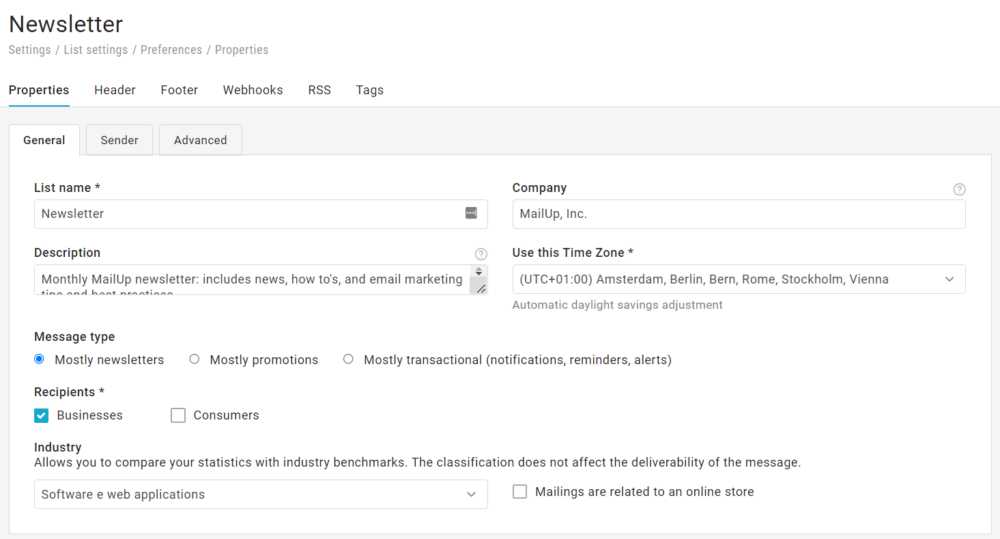Mailing lists and Segment lists: what they are, how to create them, and the differences

Among the ten commandments for building a quality database, a major one is to create valid, profiled mailing lists. They are then used as a starting point for relevant and personalized email campaigns.
Without this first step, any Email Marketing activity could prove to be ineffective and cumbersome. Sending emails by manually entering every single email address is unthinkable for a company that wants to grow and optimize its work time. Then again, not having data available on your recipients means moving blindly and speaking to an unknown audience, with poor results.
So, let’s see how to get started and what best practices to adopt to maximize the effectiveness of your mailing lists.
Before you start
Having a professional Email Marketing tool not only allows you to automate bulk emailing, but also to collect email addresses and contact data that you can manage in a single platform.
And you’re wrong if you think using this kind of tool is expensive or particularly difficult. In this post we will show you how creating a mailing list with a platform like MailUp is not only easy and foolproof, but also a significant time saver.
If you have your doubts, why not put us to the test? Click here to activate the MailUp trial. Click here to activate the MailUp trial version. It’s free of charge.
What’s a mailing list
A mailing list is a collection of email addresses that receive messages from domain where the sender is registered.
Even today, many people consider the mailing list as a single container of recipients who they send the same emails to indiscriminately, following a one-size-fits-all approach.
In Email Marketing today, this type of approach has given way to a more advanced view of the mailing list. It is seen as a collection of addresses that are sorted into sub-groups and segments, useful for diversifying email campaigns based on recipients’ interests, behavior and master data.
Mailing list vs. Segment list
A segment list refers to a list of profiled email contacts. The list is used not only to collect email addresses but also demographic, behavioral and interest data to create segments (or groups) within the mailing list. That makes it possible to send different email campaigns depending on the target audience.
Today, in fact, profiling concepts (collection of contact data) and segmentation (use of that data to create targeted groups within the mailing list) are essential for successful Email Marketing.
A McKinsey study says 71 percent of consumers expect to receive personalized emails and 75 percent are frustrated when companies do not meet this expectation.
MailUp’s concept of a multi-list environment
To adapt to the evolution of this segment list concept, MailUp has always made multi-list environments available to its customers.
What do we mean by a multi-list environment? It means that within a single MailUp platform you can create different mailing lists, distinguished according to the type of email and SMS mailings, and subscribers. In fact, each list has its own autonomous management system, with its own recipients, unsubscriptions, preferences and types of communication.
Each list in MailUp is itself a container that can be subdivided into infinite groups, thus creating different mailing categories.
So, we have 2 levels of segmentation:
● Level 1: segmentation by list (single platform > several lists)
● Level 2: segmentation by groups (single list > several groups)

How many and what list environments you need: examples of mailing lists
A company may need to create several mailing lists within a single MailUp
platform. Which and how many mailing lists you need depends on the type of industry and business, but also on how advanced and effective you want your segmentation activities to be.
Our advice is to provide separate mailing lists by types of email and SMS communications. This is an essential point to guarantee not only optimal performance but also respect for your subscribers’ initial consent when they signed up.
In other words: having a single list from which to send different types of content, such as newsletters and promotional DEMs, may be irrelevant to one of your contacts who is only interested in receiving newsletters and perceives your offer emails as annoying. Having multiple mailing lists and giving your contacts the opportunity to decide which ones to subscribe to is a best practice that should not be underestimated. If it is not adhered to, your contacts could well permanently unsubscribe from your entire database or even worse, indicating them to flag your emails as Spam.
Here are some examples of mailing lists that an ordinary company might find useful for its platform:
● Newsletters
● Promotions
● Transactional messages
● Prospects
● Service communications
● Loyal customers
● Occasional customers
● Partners
● Inactive contacts
● Foreign markets
Multiple mailing lists are available in the Plus, Premium and Enterprise editions of the MailUp platform.
If you would like to upgrade your edition, fill out this form to receive a free consultation from our team of experts!
What you need to create a successful mailing list
What do you need to start one? These are the essential tools that you must have in your starter pack if you want your email campaigns to succeed:
● A professional sending platform, with multi-list environments such as MailUp (read on to find out what multi-list means)
● Online (website, blog, e-commerce etc.) and offline (event attendance, physical store etc.) channels to collect contacts
● A contact base, no matter how narrow, to start from
How to set up a mailing list with MailUp
1. Choose the sending platform
Why is it so important to use a professional Email Marketing platform? There are several reasons:
- you have ready-to-use database building tools for collecting contacts (sign-up forms, profiling forms) and tools for building the sign-up flow (sign-up confirmation emails, post-sign-up pages and welcome emails)
- you have everything you need to collect addresses, build mailing lists, send messages to collected contacts, and manage contacts and group them into segments in one tool
- it guarantees you secure sending list creation, with all the tools to profile contacts and enrich their profiles with useful data while complying with the GDPR
- it provides you with all the useful elements to keep your lists clean and monitor the presence of bounces (MailUp, for example, gives you the possibility to automatically manage bounces and safeguard your email delivery capacity)
What are bounces? They are returns that occur when an email sent to an address is rejected by the recipient’s mail server. Bounces can occur because of a temporary error (called a soft bounce) such as an overfilled inbox or server outage, or because of a permanent error (called a hard bounce) such as a nonexistent email address.
- it provides you with support and advice whenever you need it, working with you in these operations if you need help.
2. Import your contact base into the platform
Whether you are using a sending platform for the first time or switching from another platform to MailUp, importing your contacts is the initial step in creating a sending list for sending mass email campaigns without manual intervention.
If the word import scares you, keep in mind that instead it is a very simple step that takes seconds.
With MailUp there are several ways to import your list:

Once you have chosen the import mode, all you need to do is upload the file with all your email addresses and associate each column in your file (first name, last name, email address, etc.) with the corresponding master field (always first name, last name, email address).
Once the contacts are uploaded, you will have your first mailing list, nothing more than an independent set of messages, recipients, settings and statistics.
3. Segment your contacts into groups
Now that you have your mailing list, you can organize the contacts on your list into groups and create goals for your targeted campaigns.
With the Groups creation feature in MailUp, you can easily group contacts that have common characteristics (in master data, interests, or activities) and name the group you create, so that it can be easily found when sending email.
Groups vs. Lists
It is important to distinguish between the two concepts of mailing list and group.
Group: A set of recipients within a List. A recipient can belong to one group, to several groups at once (as happens in “Categories” in MS Outlook) or to no group at all.
List: an independent set with its own list of messages, senders, statistics, automatic mailings, lists of recipients (suspended, subscribed, unsubscribed) and groups. The adjective independent means that a list’s message, statistics, groups, and subscriptions are not visible and cannot be used in other lists. Thus, a recipient can be subscribed to only one list (e.g., if he or she is a customer, he or she will be subscribed to the “Customers” list and not to the “Prospect” or “Partner” lists) or he or she can be subscribed to more than one list (to the “Newsletter” list and to the “Promotions” list) if, for example, he or she has consented to be subscribed to more than one list during the subscription process.
But what is the relationship between lists and groups?
Lists can contain many groups. The list is thus a container of groups, which in turn are containers of recipients.
A recipient who is subscribed to more than one list, however, has a status (subscribed, unsubscribed, or suspended) for each list, so a recipient may have subscribed status on one list and unsubscribed status on another list.
You don’t trust us? See what others say about our platform: read this review.
How to handle multiple mailing lists
Managing many mailing lists is very easy with the dashboard you find on the left when you log into MailUp:

You will be able to select up to five lists and have details for each one on:
- last edited message
- statistics for the last 30 days
- recipients subscribed to the list and the percentage out of total subscribed, suspended and unsubscribed.
Instead, by clicking on the Manage Lists button you can get a list of all the lists you have created, create a new list, see the settings for each individual list, or proceed to delete a specific list.

Helpful tools for managing multiple lists
While the presence of multiple lists, is a highly recommended best practice, it may require different people in the company to manage communications and monitor activities for a specific list.
MailUp provides you with two different tools to enable you to manage your multi-list environments with multiple people on the team or in the company.
1. The Additional Administrators tool
With this tool, available in the Plus and Premium versions of MailUp, you can also invite other team members and colleagues to access specific areas of the MailUp platform and work with you on certain lists, managing permissions and access in a flexible and customized way.
If you would like to upgrade your MailUp edition to the Plus version, fill out this form to receive a free consultation from our team of experts!
2. The Collaboration tool
Collaboration is the tool that facilitates team sharing and approval of email-related projects.
What it allows you to do:
- share a created email campaign with as many colleagues as you want
- have all team members add comments and notes with one-click on any graphic and textual element
- each comment gives rise to an orderly and easy-to-follow exchange of opinions and review modes
What are you waiting for? Start building your mailing lists with the Plus edition of MailUp!
And if you haven’t tried our platform, we have a free trial for you! Activate it now by clicking on the banner here below: